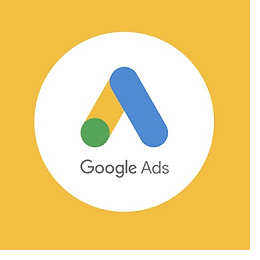
You: an Amazon seller or influencer with a store or shop who’s invested in a PPC campaign with hopes of driving traffic to your product listings or your storefront in order to drive sales.
Your frustration: You are seeing a great click-through rate but almost no sales, which is odd because it’s entirely out of line compared to the conversion rates for your products. So, the question is: why?
If you’re an Amazon Seller, your paid search ads for Amazon may not be delivering much retargeting benefit, so the ROA is close to zero—and yet, your overall sales during the campaign went up. How is that possible?
You double-checked your ads, and they are set up correctly with Amazon Attribution tags (or affiliate tags if you’re an influencer). The link leads the shopper to the product details page or storefront, however, you’re testing the link with a desktop computer and you’re logged into Amazon.
But wait— have you checked the behavior of that Amazon link from your paid search ad using a mobile device?
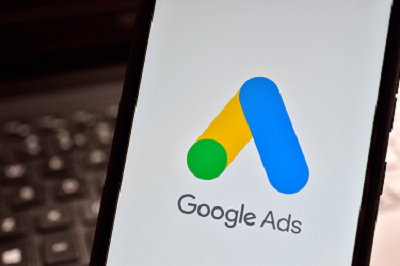
No, you won’t see an error message, but you will notice that the link sends your shopper to the Amazon web login. That’s right, instead of opening the Amazon app, the link behind the ad opens the browser to the Amazon web login page—even though the app is installed. Could that be the issue?
At this point, you might be thinking, ‘Well, okay, I’ve seen this kind of thing before, but this issue can’t be the reason behind the underwhelming numbers, could it?”. After all, as consumers, we’ve all had that experience, but what can we do about it?
Of course, most consumers abandon their shopping journey, or jump over to the Amazon app themselves, so it makes sense that attribution tags weren’t passed by the link.
And there it is! That’s the problem. We’re going to explain why in a moment, so before you conclude that it’s not a big deal, let’s set up the scenario for you—
Let’s say our potential customer just searches for a phrase that you happen to bid on, and sees your paid search ad. Awesome! Your product on Amazon has caught their eye so much so that upon reading the details of the ad, they decide that they’d like to buy the product immediately.
Even more awesome! Click. The Amazon login page appears. Ugh, annoying.
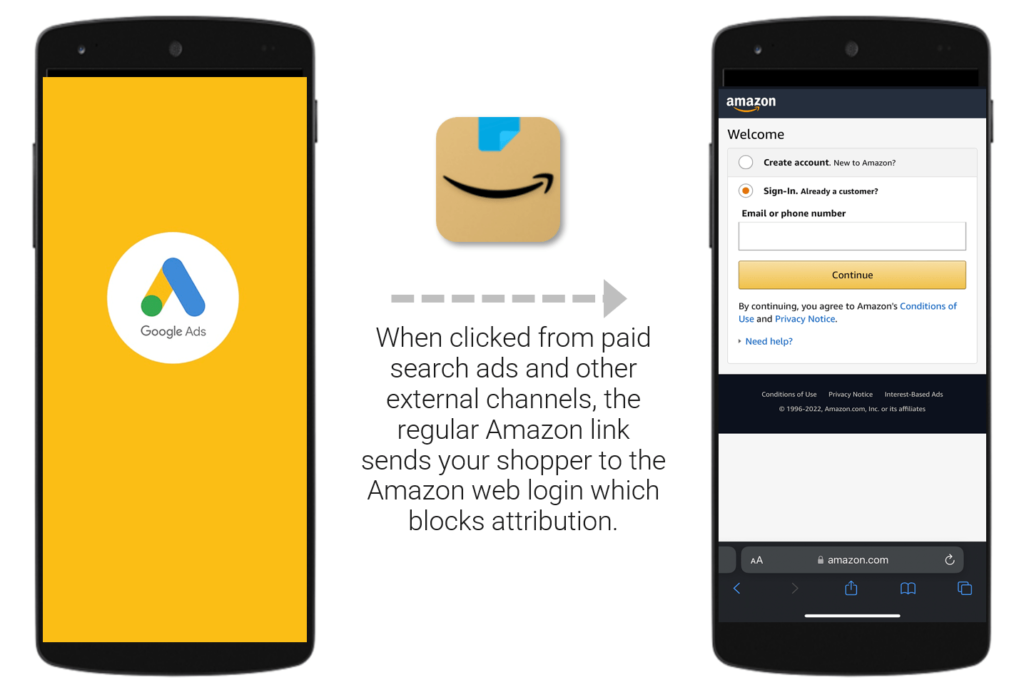
At this point, one of two things is likely to happen:
1) Your customer abandons their shopping journey because they don’t remember their Amazon login information (the app is always logged in)
2) The customer jumps over to the Amazon app to search for your product, where they may or may not find it (but they might find your competitor, instead!).
Yikes. That’s a conversion blocker—or source of ‘friction,’ as we say in marketing. Either way, that attribution connection is lost. Even if the customer jumped over to the Amazon app and bought the product (yay!), your campaign would still not get credit for the sale (boo!).
It gets worse—Amazon sellers also miss out on measuring how many customers viewed product details or added items to their cart to buy later. So, you end up missing out on sending those potential customers to the Amazon DSP for remarketing. In other words, your campaign generates almost zero measurable benefits. That’s why you’re seeing clicks on the Amazon Ads Console, but no conversion—despite your overall sales seeming to increase, all while your campaign receives 0 credit for these marketing efforts.
And worse (really)—Are you an Amazon seller trying to earn the Amazon Brand Referral Bonus on your paid search campaign? If the sales from your off-site campaigns—including Google Adwords—are not measured by Amazon Attribution, you can’t earn the Amazon Brand Referral bonus, which could be 10-30% of the sale!
But why does this happen? It’s called the “walled garden,” and it’s costing you money (and we should mention that it isn’t Amazon’s fault, but we’ll get into that in a bit).
So, let’s get into it and learn how URLgenius’ patented app deep linking platform is designed to solve this very problem. And worry not: URLgenius is a verified Amazon partner, and therefore your links are already optimized for just about every screen in the Amazon app (i.e., billions of them).
The walled garden refers to the invisible barrier that prevents the link from opening the destination app (Amazon in this case), and instead keeps them in the web browser. Or, the link keeps them within the app they’re in (e.g. the Google Search app).
In layman’s terms, the user is stuck at the login page (because of the walled garden). There’s nothing necessarily wrong with your link or with your Amazon Attribution—what you’re seeing is an industry-wide problem when linking from app to app. Your link just needs to be updated so that it can open the Amazon app and go straight to your product or store.
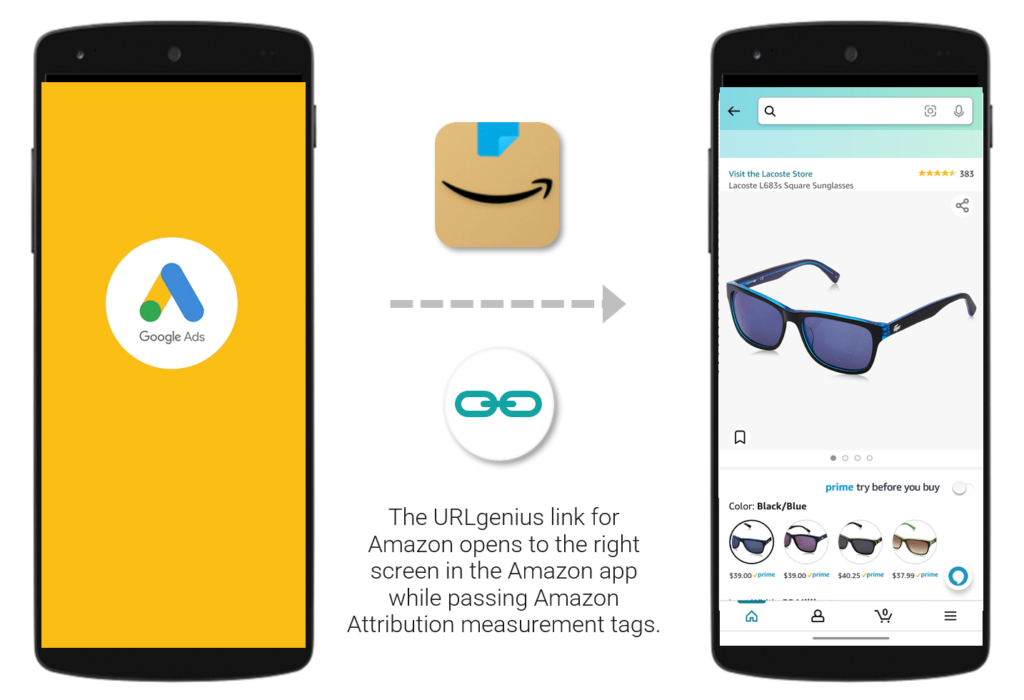
Our one-of-a-kind, patent-protected Amazon deep link generator is made for marketers and lets you make your own Amazon app deep links in just a few minutes. Oh, and by the way, you don’t need any SDKs or additional technical resources to do this, so we really mean it when we say you can solve this problem in mere moments.
So, let’s get started with a step-by-step tutorial on how to create an Amazon deep link that will allow your ad to securely navigate the walled garden and open the Amazon app to the appropriate screen.
An important thing to keep in mind when setting up your paid search campaigns is to use the tracking template feature. Your URLgenius link will not be the link for the ‘Final Destination’ field. URLgenius is a redirect platform. Your final destination is still the regular Amazon link.
If you don’t use the tracking template feature, your Google Paid search ad wil be rejected with a domain mismatch error, which is not exactly helpful, but it’s because you have the URLgenius link in the wrong field.
To use the Tracking Template feature in the Google Ads setup, just scroll down on the ad setup page to see this option. Contact us for help in setting up your Google ads.
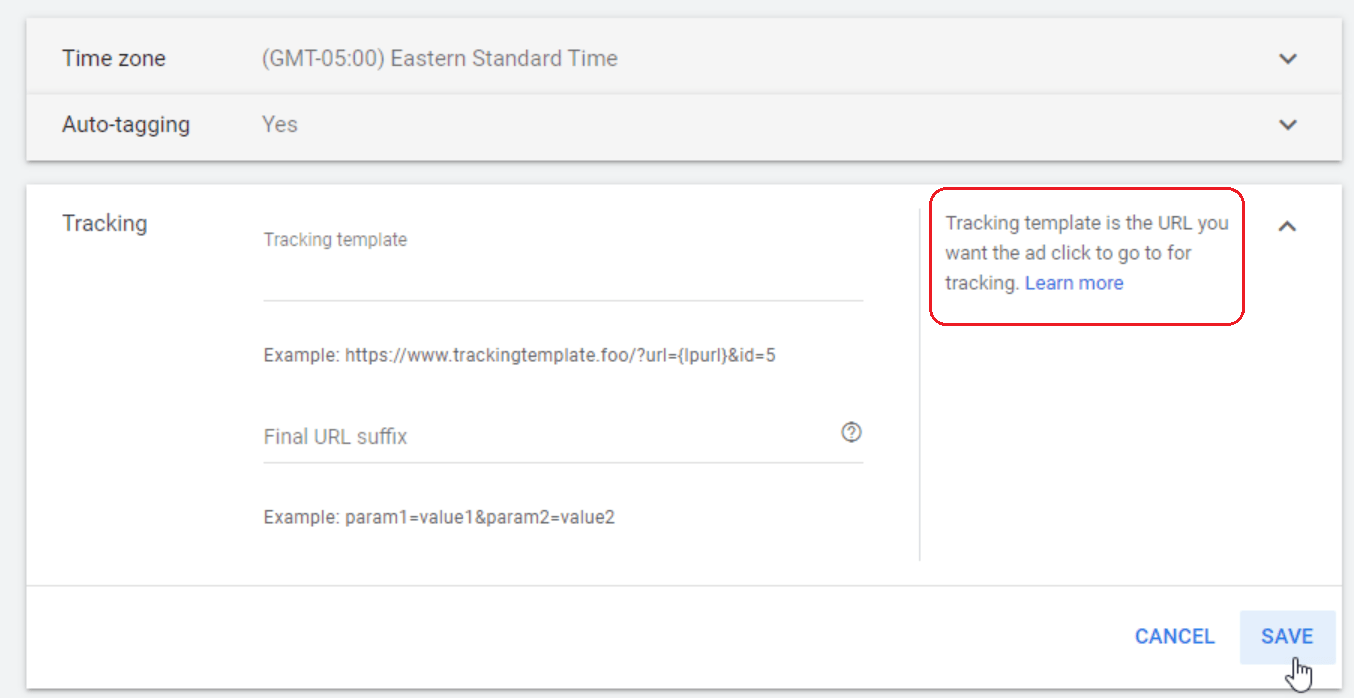
Here are the steps for updating your regular Amazon links. This is a tutorial for a single link. If you need to create Amazon app deep links for advertising feeds and other solutions, URLgenius offers enterprise customers access to an API.
Sellers should know that URLgenius is the only verified Amazon Ads partner that can pass Amazon Attribution measurement tags without SDKs. Follow these steps and update your campaign links today.
Influencers should always create their links with their affiliate tags included.
If you’re an Amazon Seller enrolled in the Amazon Attribution program, you can authenticate your Amazon account in the settings for your URLgenius account. If you generate your link without tags, click the ‘attribution’ tab in the settings for your link, and URLgenius will automatically include your Amazon Attribution tags. Or, Amazon sellers can generate their Amazon links with attribution tags in the Amazon console first.
To create an Amazon app deep link for Google paid search ads, you start with the link to your product or store. Paste the link into the URLgenius homepage to update the link so it can open the Amazon app. You can use your brand’s domain for your app deep link, which we recommend.
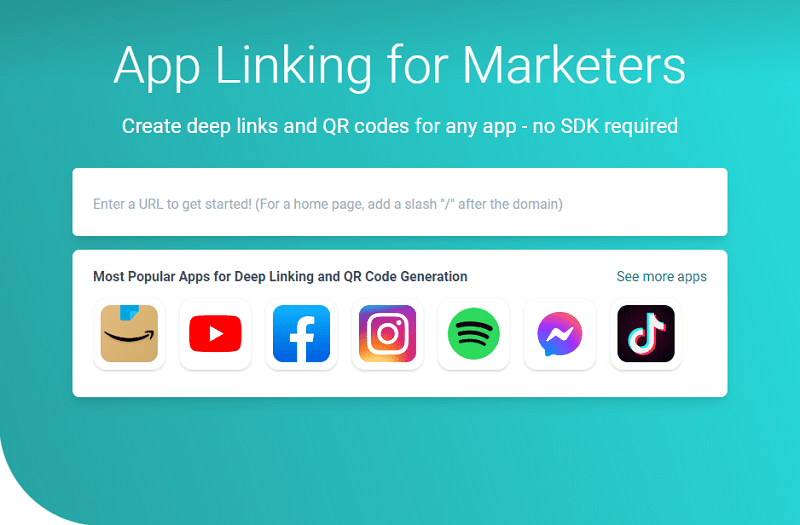
Notice that you are given the option to customize the end of the URLgenius link for Amazon to align it with your campaign. This will also help you find the link later in your list of links in the URLgenius dashboard.
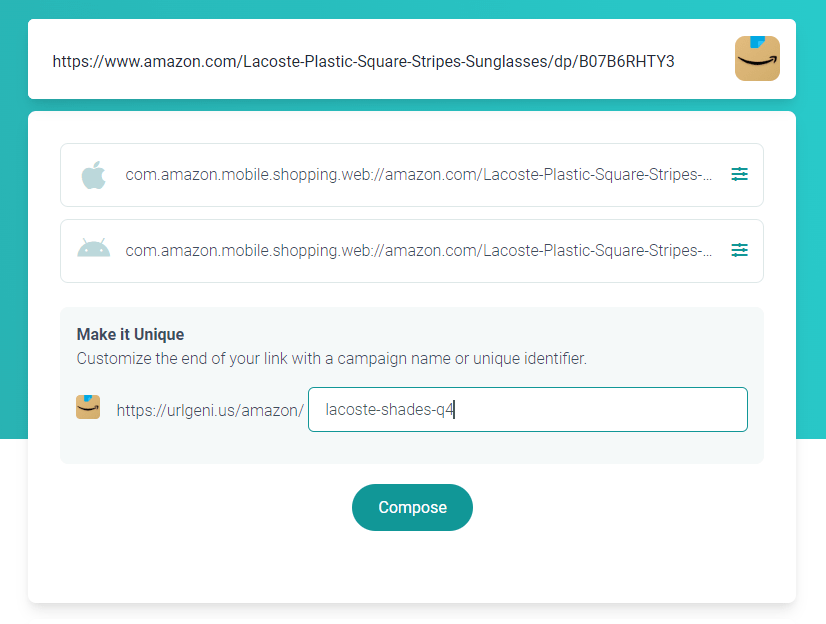
After that, simply select “Compose” and you’ll be taken to the settings page for your Amazon app deep link. To go back to the settings page later just click ‘Console’ from the menu.
From the settings page of your Amazon app deep link, you can copy it to place into your paid search campaign. First, however, it’s a best practice to test your Amazon app deep link which you can do by scanning the QR code or clicking the button to email it to yourself.

Need a QR code that opens the Amazon app to that same product? You’re in luck! Every URLgenius Amazon app deep link also comes with a Amazon QR code. Just click “QR Settings” to download and customize. You can change the color and logo and density (scanning distance) and more.
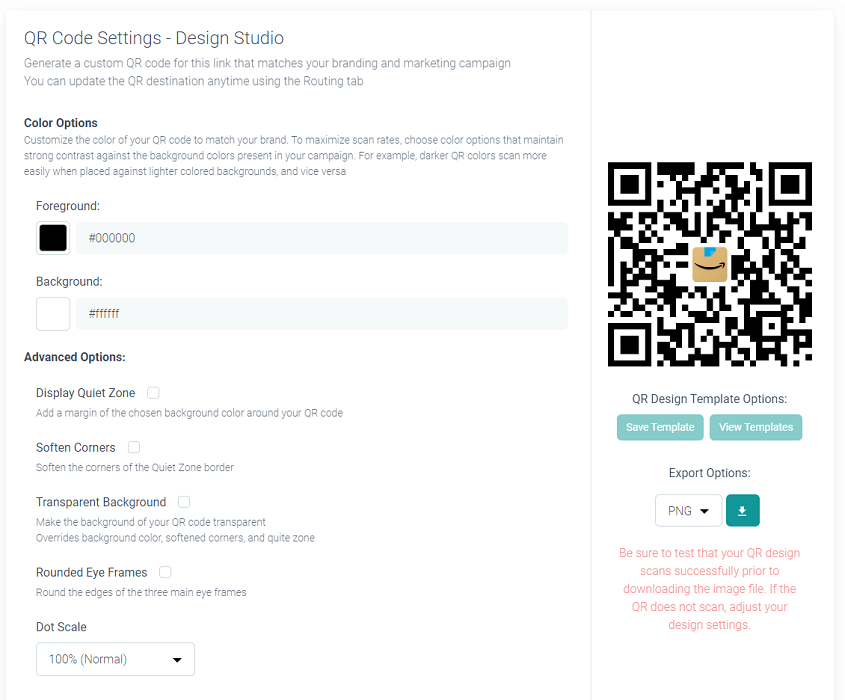
URLgenius will track app clicks, app-opens, and other information— such as referring URLs and referring apps.

The following chart shows the volume of Instagram app-opens by platform and device. The app-open rate tells you what percentage of people who scanned had the Facebook app installed for iOS and Android.

This chart shows scans by city and separately by language preference. These anonymous insights help you figure out where and how to focus your campaign, both in terms of geography and language.
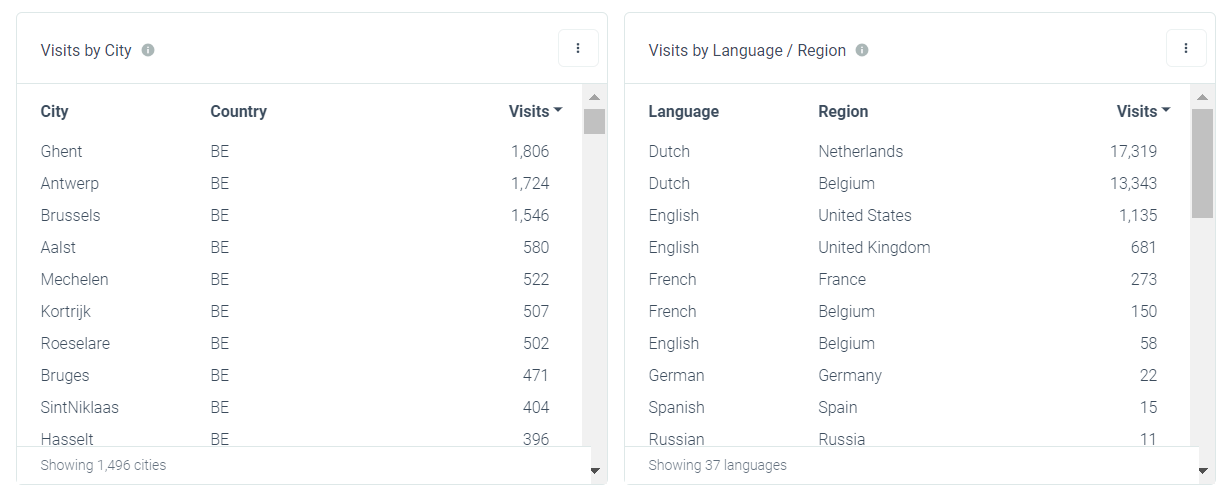
More sales, increased re-marketing, and higher product rankings = more $$$—need we say more? It’s time to maximize your off-site Amazon advertising efforts with app deep links today.
If you found this content helpful, check out some of our other popular how-to posts:
Categories
Submit a Comment